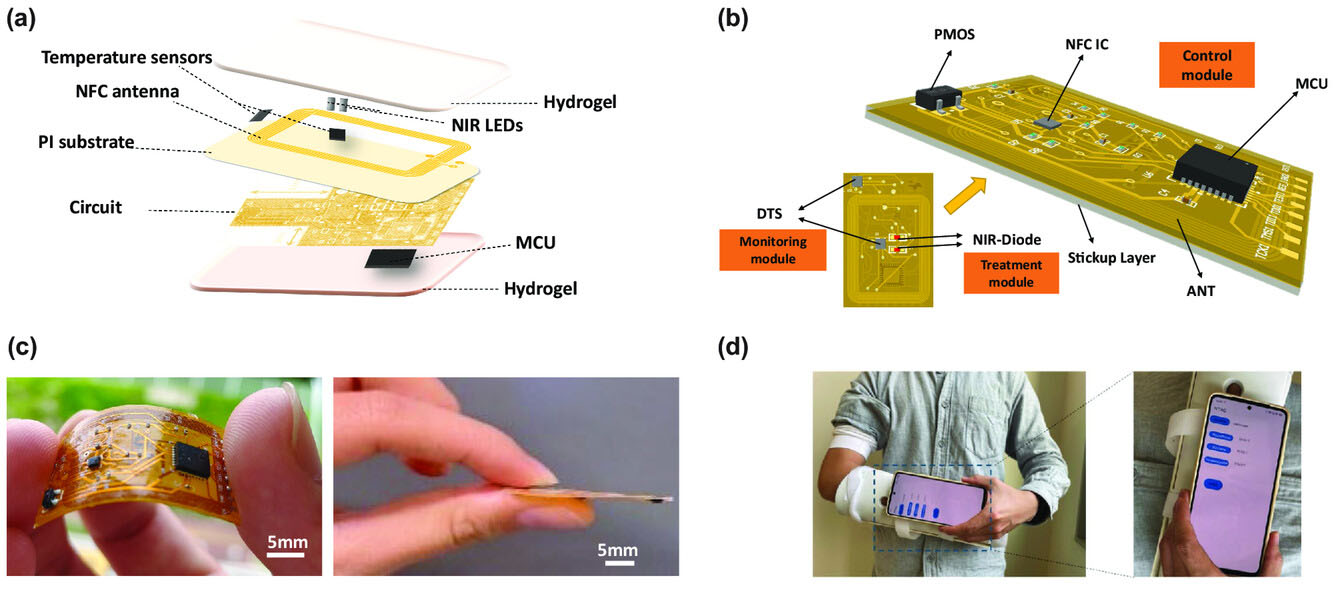| Feb 09, 2024 | |
The humble bandage gets a smartphone-powered electronic upgrade |
|
| (Nanowerk News) For millions suffering from chronic lesions, burns and post-surgical complications, their wounds can mean persistent pain, risk of infection, and reduced quality of life. And while modern medicine has tremendously expanded treatment options, there has been minimal innovation in one ubiquitous remedy – the humble bandage. Yet emerging research now seeks to transform these passive dressings into active healing devices. | |
| Recent advancements in bioelectronics point to an intriguing method using near-infrared light. Extensive studies have shown near-infrared radiation can energize cells to drive faster recovery across all processes from inflammation to tissue regeneration. But current near-infrared equipment is bulky, inconvenient and inaccessible to the average patient. | |
| Now, an interdisciplinary team has released a groundbreaking solution resolving this disconnect. As detailed in Advanced Intelligent Systems ("e-Bandage: Exploiting Smartphone as a Therapeutic Device for Cutaneous Wound Treatment"), the researchers have engineered a flexible electronic bandage system combining miniaturized near-infrared LEDs with sensors, electronics and wireless power harvesting from an NFC-enabled smartphone. This integrated platform aims to make advanced phototherapy practical while enabling continuous monitoring - finally unlocking the bandage’s untapped therapeutic potential. | |
 |
|
| e-Bandage structure, and composition. a) e-Bandage structure: hydrogel encapsulation layers, NIR LED pair, sensors pair, coil antenna, and circuit on the flexible PI substrate. b) Surface-mount components, that is, control/communication module (on the top) and monitoring and treatment modules (on the bottom). c) Flexible e-Bandage circuit before encapsulation. d) Stable wireless monitoring for wounds protected by plaster. (Reprinted with permission by Wiley-VCH Verlag) | |
| Remarkably, this integrated system harvests wireless electromagnetic energy from an NFC-enabled smartphone to power its functionalities. Placing a smartphone near the e-Bandage creates a coupled magnetic field that provides sufficient electricity for therapy and sensing with no batteries required. | |
| Beyond portability, the e-Bandage delivers localized NIR irradiation to stimulate wound healing through multiple mechanisms. By absorbing the NIR energy, skin and subcutaneous tissues increase blood circulation, cellular metabolism, collagen production and more - accelerating every stage from inflammation to tissue regeneration. Studies have already shown NIR phototherapy to be highly effective for chronic wounds, burns, infections and other lesions. | |
| Additionally, the research team demonstrated the immense potential of continuous, real-time wound monitoring - an innovation that could enable personalized interventions and optimal treatment timing. Through an embedded temperature sensor pair, the e-Bandage can precisely track differential temperatures to identify healing progress and predict healing stages. | |
| For example, acute inflammation causes wounded areas to become hotter than healthy sites due to increased blood flow and cellular activity. Later, temperature differences decrease as tissue regeneration commences and fresh skin layers form. Analyzing such thermal patterns provides actionable insights into an unseen wound’s status for timely therapeutic adjustments. | |
| The researchers validated the dual capabilities of combined NIR therapy and physiological tracking through comprehensive technical evaluations and animal studies. Wireless energy transfer efficiency and subcutaneous light penetration depth simulations affirmed the platform’s effectiveness for deeper tissue treatment. | |
| Controlled experiments using skin wound models in rats further verified acceleration across all wound recovery phases. Notably, near-infrared irradiated wounds demonstrated over 30% faster closure by the conclusion of a 14-day trial. Histological analyses evidenced enhanced re-epithelialization, granulation and cellularity compared to control bandages. | |
| Matching thermal measurement data also successfully delineated inflammation, tissue formation and late-stage remodeling via temperature fluctuations - proving the concept of stage prediction through differential sensing. With such capabilities, the e-Bandage system could detect complications or stagnation earlier to prevent chronic wounds. | |
| Altogether, the research highlights prominent advantages over previous wound management technologies and intelligent bandage prototypes. The stand-alone, flexible platform offers programmable photonics therapy paired with diagnostic sensors in a miniaturized, cost-effective, patient-friendly package. | |
| The undergraduate co-first author Mengxia Yu noted, “The user-friendly, efficient wound management platform promises a revolutionary step toward accessible and efficient at-home wound care.” | |
| However, the innovators identify remaining limitations and challenges for advancing the pioneering e-Bandage from proof-of-concept to practical medical product. Ongoing and future aims include enhancing therapeutic longevity for all-day use, improving functionality via multi-parameter sensing, monitoring drug delivery and refining flexibility to accommodate varied wound shapes. Larger animal trials over longer periods will also further validate clinical translation potential before pursuing ultimate human studies. | |
| Nonetheless, the holistic info-therapeutic system highlights growing intersections between bioelectronics and intelligent medicine for closed-loop, data-guided disease intervention and personalized care. The researchers conclude that their convenient smartphone-powered platform offers broad applicability for at-home therapy and chronic disorder management - setting the foundation for preventative wound monitoring and treatment automation through artificial intelligence systems down the road. |
| Source: Nanowerk (Note: Content may be edited for style and length) |
We curated a list with the (what we think) 10 best robotics and AI podcasts – check them out!
Also check out our Smartworlder section with articles on smart tech, AI and more.

